

This is an S-100 bus computer with Seattle Computer Products (SCP) cards. It has an Intel 8086 processor. I bought it sometime between 1985 and 1986, exactly as pictured, from a guy who had used it for his business between 1983 and 1984. I needed it for a small software venture I was working on at the time, plus, some CS classes at Colorado State University. This came in very handy not having to stand in line at the computer lab waiting for a terminal to free up.
If you've never seen one of these, S-100 buses were popular with microcomputer architectures prior to the IBM PC. S-100 based computers are unlike PCs in several major ways, however. The most obvious difference is that the system is not defined by it's main logic board like with a PC. Instead, the main board is nothing more than a collection of 100 pin sockets connected together, providing multiple plug-in access points to a common bus. The processor board is plugged into the bus just like memory boards, disk controllers and serial port boards are. If, one day, you want to switch from a Z80 to an 8086, you can swap the CPU board (for the most part), where with a PC, you'd have to replace the motherboard and probably the memory too. Another major difference is that the S-100 bus feeds unregulated DC power to each board, which must provide it's own regulation as needed. PCs use switched power supplies that provide regulated power to the entire system.
The computer came with over 20 boxes of 8" floppies - 2 of the boxes were unopened and still shrink wrapped. These disks turned out to have lots of different software apps, including several compilers (FORTRAN, C, Pascal, BASIC, MASM, etc), CP/M and MS-DOS (v1.25 and v2.0.) Talk about "back in the day," these versions of DOS didn't support device drivers. To add a parallel port, or add/remove a floppy drive, for example, you would have to reassemble the kernel. This included editing an assembly language configuration file, reassembling the binaries and relinking the binaries into the core system files (i.e. this process created new IO.SYS and MSDOS.SYS files on the fly!!) So the source code was distributed with the system disks! Another interesting thing was that DOS v1.x didn't support subdirectories - there was no intrinsic or extrinsic "MKDIR" or "MD" commands. Of course, with such limited diskette capacities (remember, this was pre-hard drive DOS), who needed it?! A single sided, single density 160K floppy disk could only hold so many files after all. Plus, v1.x only supported FAT12, 40 track, 8 sector formats per side. Double sided, these floppies could reach a 320KB max capacity.
After I bought my first IBM PC compatible in 1987, I pretty much parked this S-100 system in closets and basements for about 18 years. After moving from Denver's dry climate to Seattle's rainy climate in 2005, I pretty much left the components neatly packed away in their moving boxes. Over the years, I've thought about getting rid of it several times. However, something deep down inside kept telling me to hang on to it, almost like I had a duty as a trustee of something special. Today, I'm very glad I did. After working with computers for over 22 years now, I have gained a true appreciation for vintage hardware like this. As it turns out, there are a lot of other folks who do too. There are several amazing computer museums around the world, plus several active enthusiast groups who restore, maintain and even prototype new S-100 boards as a hardcore hobby.
What's really nice about this box is it's condition. Being stored away out of the sunlight has kept the components in very nice condition. I've read on the 'net about how large electrolytic capacitors, like the beer can sized one in this box, tend to bleed out over time. They're not cheap to replace, either! The 1 large and 2 medium sized caps in this box show no signs of leakage.The box still fires up and runs very well. In November, 2009, I put it all back together and started playing with it a bit, looking through old source code and writing a few routines in Pascal, just to see if I could remember how. I even played "Adventure"! I totally forgot I had a copy (and on 8" floppy!) Remember "XyzZy" and "PLUGH"? :-) I wonder how many of us have used these "magic words" as our own passwords at one time or another, LOL
This system has a new owner! It is now under the care of a wonderful chap I met through the Vintage Computer Federation forums. He will be imaging the old software and ROMs and digitizing the original manuals and will be posting them to archive.org. I will mirror these files on this website.
| Click images for larger versions | Description | Documents |
|---|---|---|
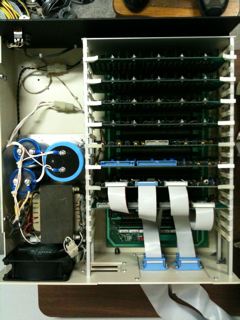
|
Top down view of the S-100 enclosure. The enclosure, backplane and power supply were manufactured by NNC Electronics. The S-100 cards are all from Seattle Computer Products and include: - SCP-210 CPU Board (Intel 8086 based) - SCP-301 CPU Support Board w/Monitor v1.9 - SCP-110 64K Static RAM board (qty 4) - SCP-500 Disk Master Floppy Disk Controller - SCP-400 Multiport Serial Card |
N/A |
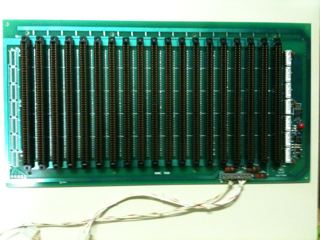
|
This is the S-100 backplane. It took me a while to figure out where the enclosure, backplane and power supply came from. At first, I thought they were all from SCP. But Tim Paterson himself confirmed for me that the "case and disk drives were from other sources." He also confirmed that the S-100 cards were indeed made by Seattle Computer. Tim Paterson worked for Seattle Computer Products from 1978-1981, and again in 1982 as a designer and engineer. He is known as the "Father of DOS", being the original author of what became MS-DOS. He graciously looked at my pictures and confirmed the enclosure wasn't SCP via email 24-Nov-2009. Learn more about Mr Paterson at his company website and his blog. |
N/A |
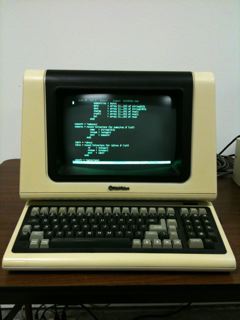
|
Televideo 950 terminal. The video is still bright and crisp, with minimal burn (just some mild burn where the status bar is always displayed at the bottom.) The light plastic pieces have yellowed a bit, but this is not from excessive exposure to sunlight. From what I've read, this is a component of a fire retardant chemical contained in the plastic itself that breaks down over time. There is now a process that remove this which uses hydrogen peroxide, an oxygen based laundry booster and UV light. Really cool stuff. These case plastics could benefit from this process. |
Operator Maintenance |
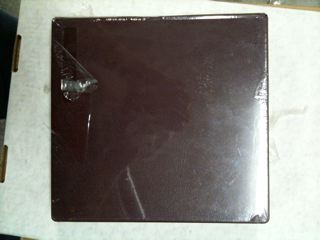
|
Box of shrink wrapped Dysan 8" floppies from the mid 1980s. There were 2 unopened boxes when I bought the system. But, thinking like an archaeologist, I opened one up back in 2000 so I could smell the air from 1985! (It smelled just like plastic, LOL) | N/A |
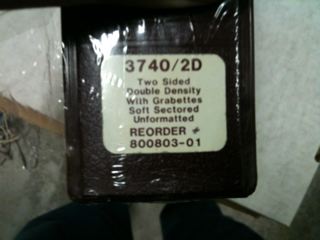
|
8" Double Sided, Double Density. Will hold 1.25MB | N/A |
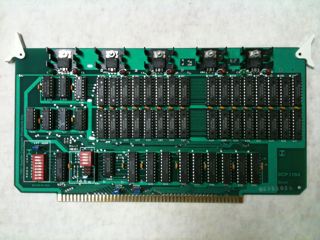
|
SCP 110 64K Static RAM Memory Card. There are 4 of these | Manual |
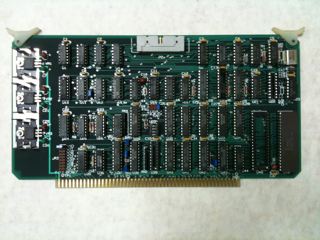
|
SCP 210 8086 CPU Board. The documentation describes how socket J22 "allows connection of an IMSAI-type front panel to run, stop, single step, and observe address and data." It continues with "This socket contains the signals INDISABLE* and OUTDISABLE* which disable the CPU regular bus controls to let you set starting addresses and data." | Manual |
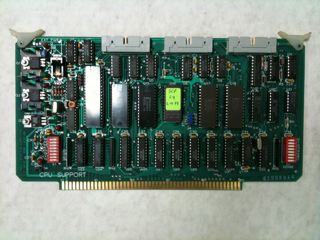
|
SCP 301 CPU Support Board w/Monitor v1.9 | Manual |
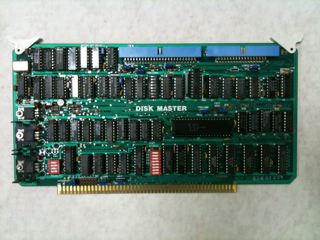
|
SCP 500 Disk Master Floppy Disk Controller | Manual |
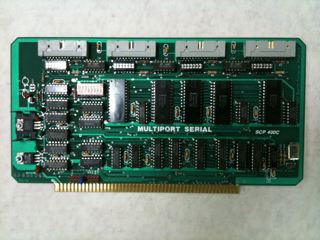
|
SCP 400 Multi Port Serial Board | N/A |
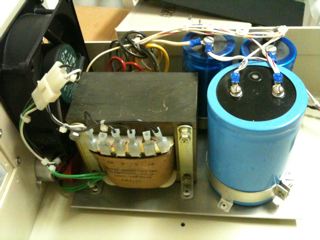
|
Power Supply - Look at the beer can sized capacitor - 150,000µF! It is still intact after more than 25 years. This is a very basic, unregulated, linear power supply. | N/A |

|
QumeTrak 842 8" floppy drives. 2 drives in a single enclosure. These drives are HUGE! | N/A |
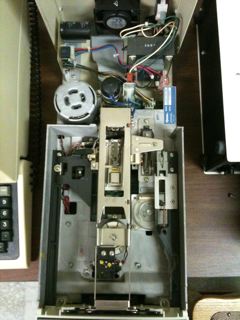
|
Single QumeTrak 842 floppy drive in a single external enclosure | N/A |
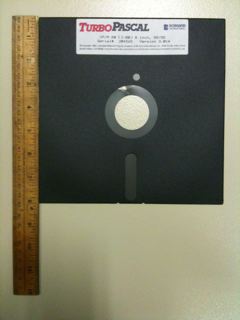
|
8" Borland Turbo Pascal 3.01 for Z80. This will not run on the 8086 CPU in my S-100 box. I bought this new around 1984 for a CS class that had Z80 computers in the lab. But I have another copy that does work on this CPU. | N/A |
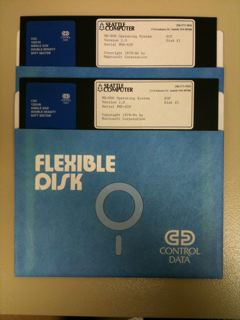
|
MS-DOS 2.0 System Disks. These are the original disks that came with the system. Tim Paterson was not involved in the creation of MS-DOS 2.0. His involvement was with the original QDOS, then 86-DOS, and MS-DOS up to v1.25. I have a copy of v1.25 in my box o' floppies shown below. | N/A |
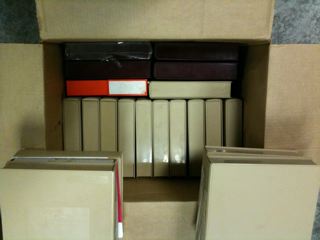
|
Several boxes of 8" floppies that came with the system. As mentioned earlier, I'm not the original owner, but the guy I bought it from back in the mid '80s was. These disks include quite an assortment of assemblers, compilers, word processors, different versions of DOS (including full source for MS-DOS 2.0, which is needed to reassemble/relink the kernel when changing hardware configurations.) Also included were blank disks and some personal disks with his own projects on them. | N/A |
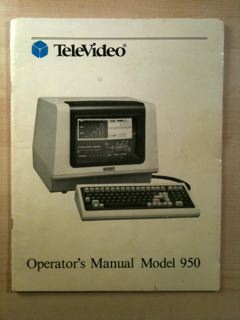
|
The Televideo 950 Manual (click for more images). This is pretty clean and has minimal markings in it by the original owner. It has 40 total pages, plus front and back covers and is Copyright 1981. | N/A |

|
I disassembled, cleaned and reassembled the S-100 box today to get all the dust out and see if I could find any helpful identifying marks on any of the components. I took pics of everything. Click the image to see some S-100 box cleanup details. |
N/A |

|
I disassembled, cleaned and reassembled the dual floppy enclosure box after the S-100 enclosure. I wanted to get all the dust out, fix some drive door sticking problems and see if I could find any helpful identifying marks on any of the components. Click the image to see some floppy drive cleanup details. |
N/A |
Page created November 22, 2009
Page updated February 5, 2024